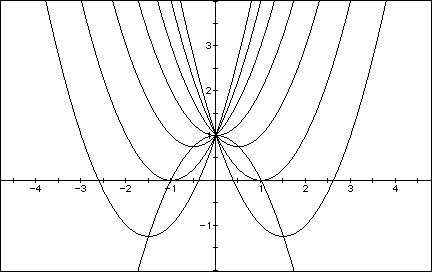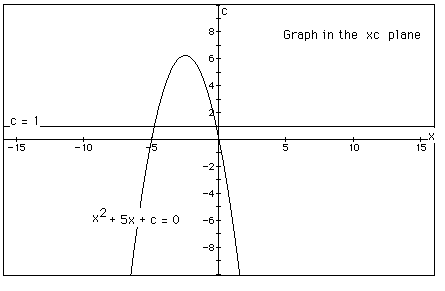

It has now become a rather standard exercise, with available technology, to construct graphs to consider the equation
and to overlay several graphs of

We can discuss the "movement" of a parabola as a is changed. The parabola always passes through the same point on the y-axis (the point (0,1) with this equation.). For a < 0 the parabola will intersect the x-axis in two points yeilding one positive root and one negative root. For a = o, the graph is a straight line, crossing the x-axis at the single point (-1,0). For a > 0, the parabola does not intersect the x-axis--thus the original equation has no real roots.
Now consider the locus of the vertices of the set of parabolas
graphed from ![]() .
.
Show that the locus is the line y = .5x +1.

Graphs in the xa plane
For instance, let us look at graphs in the xa - plane where the y-axis acts as the a-axis.

This differs from the xy- plane in that roots are found by finding the intersection of the curve and the parallel line a = n for varying values of n.
Let us use this method to find the roots of the equation: ![]() . Therefore we will need to graph the line
a = -3 and overlay this onto our curve.
. Therefore we will need to graph the line
a = -3 and overlay this onto our curve.

We will graph ![]() in the xy - plane
and compare our solutions. Since the parabola crosses the x-axis
at x= -.434259, this verifies that x = -.434259 is, in fact, a
root of the polynomial.
in the xy - plane
and compare our solutions. Since the parabola crosses the x-axis
at x= -.434259, this verifies that x = -.434259 is, in fact, a
root of the polynomial.

Let us look at the graph of ![]() for
differing values of b. For example, if we set
for
differing values of b. For example, if we set
for b = -3, -2, -1, 0, 1, 2, 3, and overlay the graphs, the following picture is obtained.

We can discuss the "movement" of a parabola as b is changed. The parabola alwayspasses through the same point on the y-axis ( the point (0,1) with this equation). Forb < -2 the parabola will intersect the x-axis in two points with positive x values (i.e.the original equation will have two real roots, both positive). For b = -2, the parabola is tangent to the x-axis and so the original equation has one real and positive root at the point of tangency. For -2 < b < 2, the parabola does not intersect the x-axis -- the original equation has no real roots. Similarly for b = 2 the parabola is tangent to the x-axis (one real negative root) and for b > 2, the parabola intersets the x-axis twice to show two negative real roots for each b.
Now consider the locus of the vertices of the set of parabolas graphed from
Show that the locus is the parabola
Generalize.

Graphs in the xb plane.
Consider again the equation
Now graph this relation in the xb plane. We get the following graph.

If we take any particular value of b, say b = 3, and overlay
this equation on the graph we add a line parallel to the x-axis.
If it intersects the curve in the xb plane the intersection points
correspond to the roots of the original equation for that value
of b.
We have the following graph.

For each value of b we select, we get a horizontal line. It is clear on a single graph that we get two negative real roots of the original equation when b > 2, one negative real root when b = 2, no real roots for -2 < b < 2, One positive real root when b = -2, and two positive real roots when b < -2.
Consider the case when c = - 1 rather than + 1.


Now consider the locus of the vertices of the set of parabolas
graphed from ![]() . Show that the locus is the line
. Show that the locus is the line
![]() .
.

Graphs in the xc plane.
In the following example the equation
is considered. If the equation is graphed in the xc plane,
it is easy to see that the curve will be a parabola. For each
value of c considered, its graph will be a line crossing the parabola
in 0, 1, or 2 points -- the intersections being at the roots of
the orignal
equation at that value of c. In the graph, the graph of c = 1
is shown. The equation
will have two negative roots -- approximately -0.2 and -4.8.

There is one value of c where the equation will have only 1 real root -- at c = 6.25. For c > 6.25 the equation will have no real roots and for c < 6.25 the equation will have two roots, both negative for 0 < c < 6.25, one negative and one 0 when c = 0 and one negative and one positive when c < 0.
Though the ax, bx, cx planes are not
typically discussed in a high school mathematics classroom, this
exploration might be an interesting way to introduce the idea
of various planes to students with previous knowledge of quadratic
functions.
Return to April's Home page
Return to Dixie's Home page